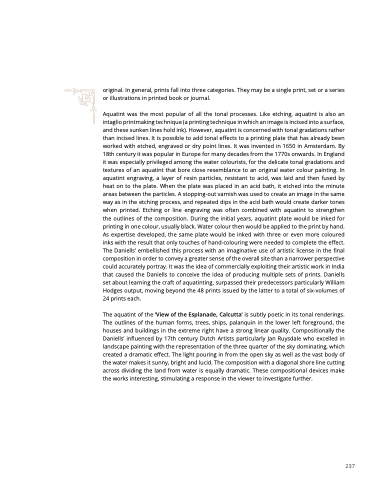Page 243 - Eye of the beholder
P. 243
original. In general, prints fall into three categories. They may be a single print, set or a series or illustrations in printed book or journal.
Aquatint was the most popular of all the tonal processes. Like etching, aquatint is also an intaglio printmaking technique (a printing technique in which an image is incised into a surface, and these sunken lines hold ink). However, aquatint is concerned with tonal gradations rather than incised lines. It is possible to add tonal effects to a printing plate that has already been worked with etched, engraved or dry point lines. It was invented in 1650 in Amsterdam. By 18th century it was popular in Europe for many decades from the 1770s onwards. In England it was especially privileged among the water colourists, for the delicate tonal gradations and textures of an aquatint that bore close resemblance to an original water colour painting. In aquatint engraving, a layer of resin particles, resistant to acid, was laid and then fused by heat on to the plate. When the plate was placed in an acid bath, it etched into the minute areas between the particles. A stopping-out varnish was used to create an image in the same way as in the etching process, and repeated dips in the acid bath would create darker tones when printed. Etching or line engraving was often combined with aquatint to strengthen the outlines of the composition. During the initial years, aquatint plate would be inked for printing in one colour, usually black. Water colour then would be applied to the print by hand. As expertise developed, the same plate would be inked with three or even more coloured inks with the result that only touches of hand-colouring were needed to complete the effect. The Daniells’ embellished this process with an imaginative use of artistic license in the final composition in order to convey a greater sense of the overall site than a narrower perspective could accurately portray. It was the idea of commercially exploiting their artistic work in India that caused the Daniells to conceive the idea of producing multiple sets of prints. Daniells set about learning the craft of aquatinting, surpassed their predecessors particularly William Hodges output, moving beyond the 48 prints issued by the latter to a total of six-volumes of 24 prints each.
The aquatint of the ‘View of the Esplanade, Calcutta’ is subtly poetic in its tonal renderings. The outlines of the human forms, trees, ships, palanquin in the lower left foreground, the houses and buildings in the extreme right have a strong linear quality. Compositionally the Daniells’ influenced by 17th century Dutch Artists particularly Jan Ruysdale who excelled in landscape painting with the representation of the three quarter of the sky dominating, which created a dramatic effect. The light pouring in from the open sky as well as the vast body of the water makes it sunny, bright and lucid. The composition with a diagonal shore line cutting across dividing the land from water is equally dramatic. These compositional devices make the works interesting, stimulating a response in the viewer to investigate further.
237


